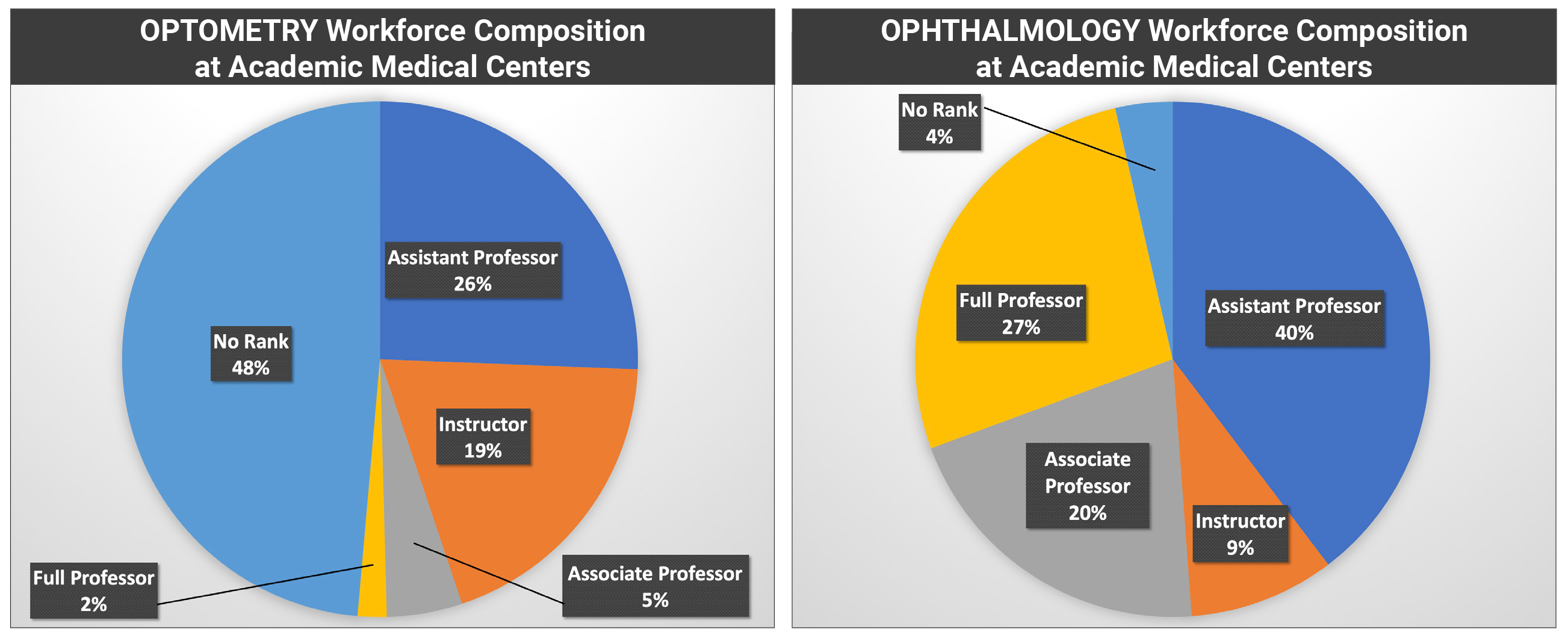 |
|
While ODs have access to promotion at many academic medical centers, the distribution of rank is skewed toward Instructor and Assistant Professor, rather than Associate Professor and Full Professor, when compared with MDs. Click image to enlarge. |
Teaching hospitals are a place where optometrists work closely alongside ophthalmologists and contribute significantly to the institution’s educational mission. Besides the training of ophthalmologists, academic medical centers are a site where optometry externs, residents and fellows are trained as well. A recent study provided statistics on optometrists who practice at these centers in the United States, along with faculty rank and postdoctoral training programs. The researchers determined that only a small proportion—just 1.8%—of the total US optometry workforce was employed at an academic medical center compared with 17.2% of the ophthalmology workforce. In aggregate numbers, US teaching hospitals employ 718 ODs and 3,181 ophthalmologists.
Notably, the distribution of academic rank among optometrists was similar across all regions but varied between institutions as to whether all, some or none of the optometric faculty were appointed by a medical school. In all cases, however, greater percentages of ophthalmologists held positions of higher rank compared to optometrists.
For this study, an academic medical center is defined as a teaching hospital that is affiliated with a school of medicine, where physicians simultaneously treat patients and sponsor clinical training and education programs for medical students, residents and fellows. The official websites of academic medical centers and schools of medicine in the United States were examined during the 2021-22 academic year to identify departments of ophthalmology and collect faculty profiles of employed optometrists. Data was gathered from the Association of Schools and Colleges of Optometry and Accreditation Council on Optometry Education to identify postgraduate training programs in optometry.
The researchers identified 192 academic medical centers, of which 63.0% had a residency or fellowship program in ophthalmology and/or optometry and 11.5% had an optometric residency or fellowship program. Also, 65.1% of these institutions had at least one staff optometrist. They noted that 718 optometrists were found at these institutions, out of the 39,205 total optometry workforce in the United States.
Of 296 optometry residency programs in the United States, 21 were at an academic medical center. Of 15 optometric fellowship programs in the United States, three were at an academic medical center. Of the 192 institutions in this study, 22 had a postdoctoral optometric training program.
Of the 718 optometrists at an academic center, 51.4% held an academic appointment at a medical school. The most common academic rank was Assistant Professor (25.6%), followed by Instructor (19.2%), Associate Professor (4.7%) and Full Professor (1.8%).
"This data indicates that the allocation of faculty rank to optometrists is based on how an institution classifies optometrists as a group, rather than the specific qualities or desires of individual optometrists to become faculty members at a particular department,” the researchers wrote in their study, published in Optometry & Vision Science. “These percentages indicate that while optometrists have access to academic promotion at many academic medical centers, the distribution of rank for optometrists is skewed toward Instructor and Assistant Professor when compared with ophthalmologists.”
One possible explanation the research team had was the relatively recent entry of optometry into academic medical centers (compared with ophthalmology), such that a higher proportion of optometric faculty happen to be at an earlier stage of their career. There may be other factors or barriers to promotion that lead to this disparity, but they believe more research is required.
While 65.1% of academic medical centers had optometrists, only 51.4% of their optometrists had an academic appointment to formally recognize their contributions to medical education.
“This gap represents an opportunity for optometry to grow and collaborate with ophthalmology, promoting a cohesive model in academic institutions that meets the rising demands of healthcare,” the researchers concluded.
Quan SC, Song S, Koepf B, et al. Survey of faculty status of optometrists at academic medical centers in the United States. Optom Vis Sci. March 7, 2023. [Epub ahead of print]. |

